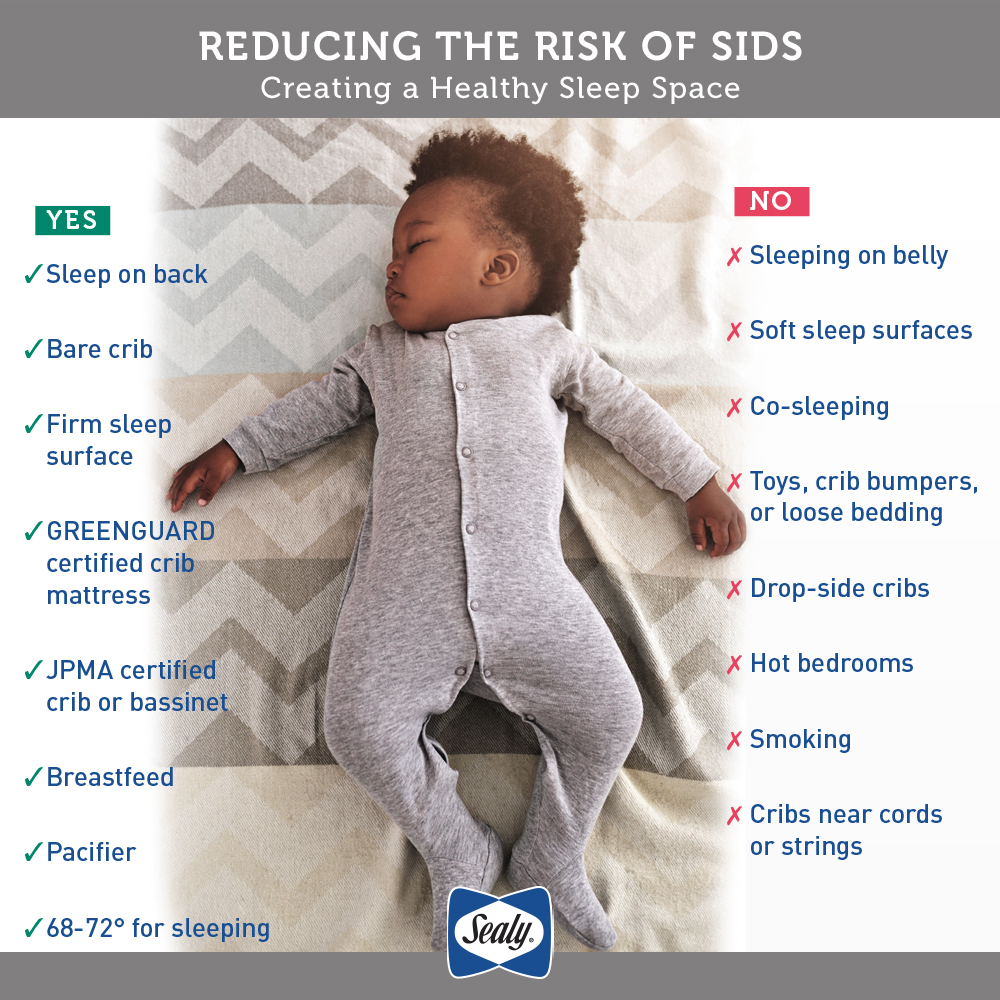
With a huge array of baby mattresses to choose from, it’s tough to know what’s the best baby crib mattress for you. Our Sealy baby crib mattress designers provide expert advice with this complete buying guide.
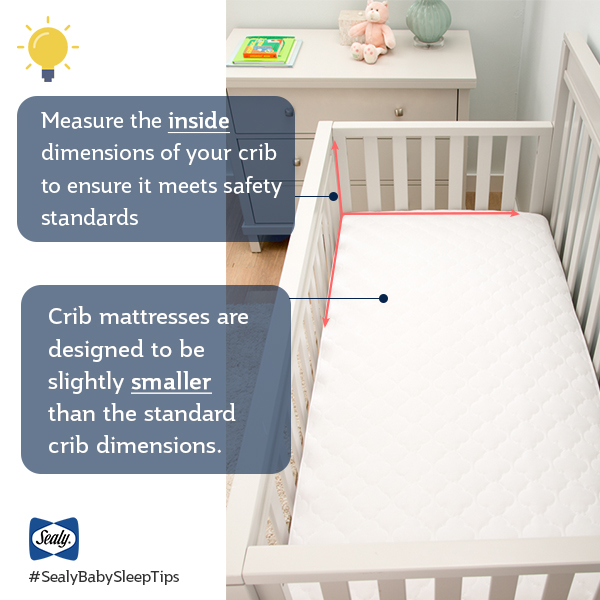
INFANT CRIB AND TODDLER MATTRESS SIZE
USA standard size cribs and toddler beds are sized with an inside dimension between 27 3/8 to 28 5/8 inches wide and between 51 ¾ and 53 inches long. Crib mattresses are sized just under that to fit properly and snugly, mostly at 51.625 inches long by 27.25 inches wide, and a crib mattress can be no thicker seam to seam or edge to edge than 6 inches.
If you see a dimension that is higher than 6 inches listed on a retailer web site, it could be a shipping dimension since many baby mattresses are shipped in a carton for protection. If you have any concern about fit in your baby’s crib, visit the crib mattress manufacturer’s web site to be sure.
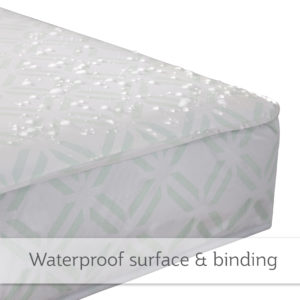 WATERPROOF IS ESSENTIAL
WATERPROOF IS ESSENTIAL
One of the most important features to look for when buying your baby crib mattress is to ALWAYS shop for one that is waterproof. Experienced parents know that babies can get messy: diaper blowouts, spilled milk, spit up, and toddler sick days happen. If your baby’s mattress is not protected, then bacteria, mold, mildew, and other allergens can grow inside baby’s mattress. Look for a mattress that is waterproof along the sleeping surface and has waterproof seams.
Whether it’s a fabric cover or a laminate cover, make sure your baby’s mattress has some type of waterproof lining or barrier.
INFANT CRIB AND TODDLER MATTRESS SIZE
USA standard size cribs and toddler beds are sized with an inside dimension between 27 3/8 to 28 5/8 inches wide and between 51 ¾ and 53 inches long. Crib mattresses are sized just under that to fit properly and snugly, mostly at 51.625 inches long by 27.25 inches wide, and a crib mattress can be no thicker seam to seam or edge to edge than 6 inches.
If you see a dimension that is higher than 6 inches listed on a retailer web site, it could be a shipping dimension since many baby mattresses are shipped in a carton for protection. If you have any concern about fit in your baby’s crib, visit the crib mattress manufacturer’s web site to be sure.
CRIB MATTRESS BASICS (construction matters)
Innerspring Coils Provide Proper Posture Support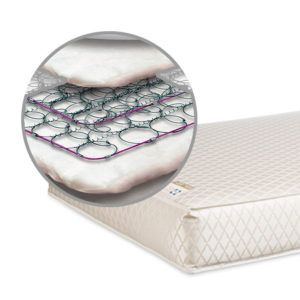
Innerspring coil baby mattresses provide posture support and cushioning that is not too hard on baby’s fragile head and bones. Coils are resilient and have some “give” so they move with baby’s body weight, helping to create support in the right areas.
A higher coil count means the mattress is going to be firmer overall. Remember, since there is one standard size for crib and toddler mattresses, a higher coil count will allow smaller and tighter springs to fit inside the space, leaving less gaps between each coil.
Sealy innerspring coils are made in the USA instead of imported from overseas, where they may be squished together and not spring back into proper shape, so coils made in the USA are a key factor in long-term quality.
Upgraded Features
When you see features such as border wire and corner protectors, these additional features really do make a difference when it comes to firmness and support in key areas. If your child sits along the edge of his toddler bed or if your baby is standing up in the crib reaching for you, these key features keep the crib mattress exceptionally sturdy along the edges or corners.
Other upgrades include comfort enhancements like two-stage crib mattress designs. A firmer side is designed for infants and a slightly softer side is designed for toddlers. Flip the mattress once your child is 18 or 24 months. Side sleepers especially will love the more comfortable side, while a firmer side is created for newborns and infants to sleep on their backs.
You can find a balance for infants by feeling the mattress and having it push back into shape. While you don’t want “brick-hard” foam or extra heavy innerspring mattresses, there are excellent options that give the right amount of cushioning and firmness so they are gentle on baby’s fragile body.
Foam Crib Mattresses Absorb Movement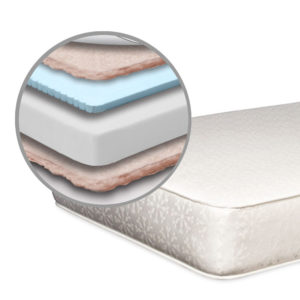
Baby mattresses made with foam or polyfoam on the inside have made a comeback in a big way. Partially because Sealy first introduced “soy-enhanced” foam into the baby market over a decade ago. These types of foams use a percentage of non-allergic soy oils filtered into the foam formula to make a durable and comfortable foam.
Look for crib mattresses that use high-density foams that are made in the USA and feature CertiPUR-US Certified foams. The certification tests for volatile organic compounds and harsh chemicals as well as lasting durability.
Foam crib mattresses will feel firmer and tend to absorb baby’s movement, especially when topped with enhancements like memory foam or cooling memory foam.
Many brands pop up with foam crib mattresses imported from overseas that don’t pass federal standards so be cautious when looking into brands you may never have heard of. These foams may not be certified or tested for safe use with baby.
SAFETY AND QUALITY CERTIFICATIONS
Here are today’s must-have safety and quality certifications for crib mattresses:
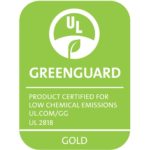 GREENGUARD Gold Certification — this test will help ensure safety overall for your baby’s mattress since the entire crib mattress and its components are tested in a lab for harsh chemicals and volatile organic compounds. A third-party laboratory is required to test them routinely to ensure the materials consistently pass the standard. Always look for the “Gold” standard when it comes to children’s products. The Gold standard is a higher level of certification required for products used with children and babies.
GREENGUARD Gold Certification — this test will help ensure safety overall for your baby’s mattress since the entire crib mattress and its components are tested in a lab for harsh chemicals and volatile organic compounds. A third-party laboratory is required to test them routinely to ensure the materials consistently pass the standard. Always look for the “Gold” standard when it comes to children’s products. The Gold standard is a higher level of certification required for products used with children and babies.
ASTM Crib Mattress Certification — we highly recommend you look for crib mattresses that pass this quality standard. This includes proper crib fit size requirements for safety in your child’s crib, but also proper sewing and labeling.
CPSIA Standards — this is a mandatory standard that no small parts, lead, or banned phthalates are found in your child’s crib mattress. Every crib mattress should comply with the CPSIA regulation.
Federal flammability standards — this is a mandatory standard to help ensure the crib mattress passes fire safety standards. There are two types of flammability standards and without passing them, the crib mattresses should not be sold in the USA. In recent years, it has been reported that some manufacturers have been shipping crib mattresses to U.S. consumers that do not comply, which results in them being recalled. Look for reputable brands that focus on quality and passing safety standards!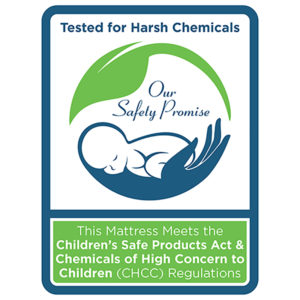
Chemicals of High Concern to Children — Washington State’s Chemicals of High Concern to Children (CHCC) Regulation – what material your baby sleeps next to is always of concern, so those that meet the 85 chemicals of high concern regulations introduced by Washington State have made great efforts to ensure there are no added harmful chemicals in your baby’s mattress.
BREATHABILITY CLAIMS TO WATCH
Despite claims from many products on the market today, no product or baby mattress prevents SIDS or suffocation. Only safe sleep practices can help reduce the risk of SIDS. Be wary of aggressive advertising that promotes placing babies face-down on crib mattresses. Placing babies on their back to sleep is best to help keep airways open. Claims from some baby mattress manufacturers are not proven with scientific evidence or laboratory tests so be aware when looking at the claims being made.
Some materials can trap heat, moisture or carbon dioxide, even mesh materials. Cotton or bamboo rayon fabrics and mesh materials are more breathable on baby’s skin than laminate or vinyl materials, which helps their bodies dissipate heat easier.
Look for an easy clean crib mattress to help create a healthier sleeping surface for your baby. In addition, crib mattress protectors like encasements and crib mattress pads that are washable can help maintain lasting freshness on baby’s sleep surface.
Some materials allow household allergens to settle more easily on the mattress surface, so a washable sheet or pad is recommended to keep dust and pet dander at bay. Claims from some baby mattress manufacturers are not proven with scientific evidence or laboratory tests so be aware when looking at the claims being made.
For more information on how to buy a crib mattress or how to properly measure your new crib, check out our additional buying guide information.
